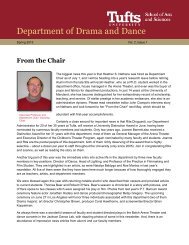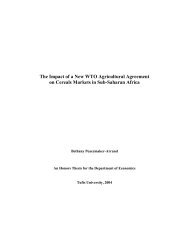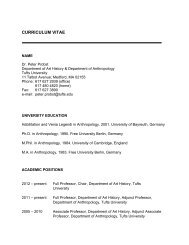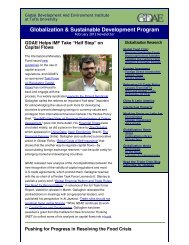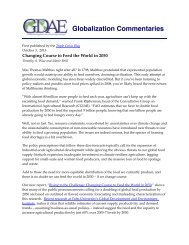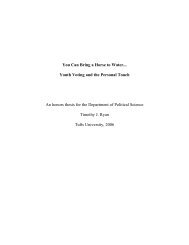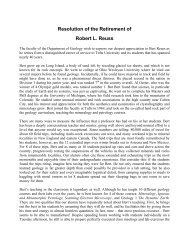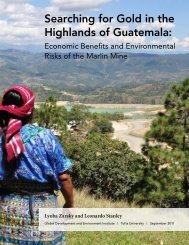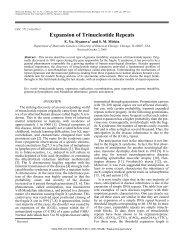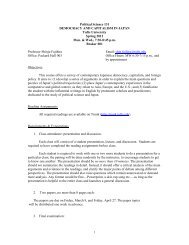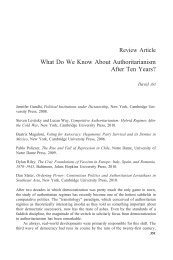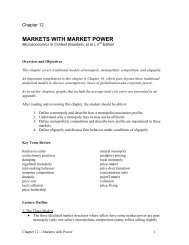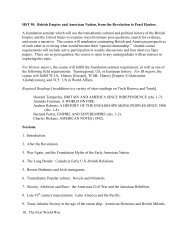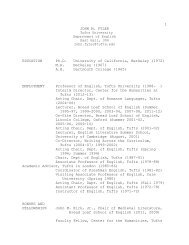Is A Main Street Program Appropriate for Mattapan? - Tufts University
Is A Main Street Program Appropriate for Mattapan? - Tufts University
Is A Main Street Program Appropriate for Mattapan? - Tufts University
You also want an ePaper? Increase the reach of your titles
YUMPU automatically turns print PDFs into web optimized ePapers that Google loves.
lishments located along the MEDI commercial corridors.<br />
In contrast, however, there are only 3 “full service” restaurants in<br />
the MEDI study area. There is only one mid-sized or large grocery<br />
store (located on the southern end of <strong>Mattapan</strong> Square), and no<br />
“superstore”-type supermarket within the MEDI study area. Simi<br />
larly, there is only one pharmacy, located on the northern<br />
periphery of the study area off Morton <strong>Street</strong>. There are no enter<br />
tainment establishments (theaters, music venues, etc.)(MEDI report<br />
2006)<br />
Hence, while the <strong>Mattapan</strong> area offers a wealth of some services, it also<br />
lacks many others .<br />
ZonInG anD URban DesIGn<br />
Another facet of <strong>Mattapan</strong>’s story is the zoning in the districts under consideration<br />
. According to Jeremy Rosenberger, the BRA’s planner <strong>for</strong> <strong>Mattapan</strong>,<br />
there are three approval levels that projects receive when they are presented<br />
by developers . Projects that receive an “A” meet all established regulations<br />
and standards . A “C” stands <strong>for</strong> conditional approval and shows that<br />
the project needs review . He gave the example of a restaurant with night<br />
music as the type of entity that might receive such a “C” approval . Any<br />
project that receives an “F” is deemed <strong>for</strong>bidden . With that rating the project<br />
can only proceed through approvals from the zoning board of appeals<br />
and significant community support .<br />
For private residences, the area is zoned as one-two-three and multi-family<br />
residential . Cemeteries, park lands, recreational areas, community gardens,<br />
and urban plazas are zoned as open spaces . Businesses in the area operate<br />
under the following guidelines:<br />
Existing zoning separates the MEDI study area’s commercial sub-<br />
districts into two types, Neighborhood Shopping and Community<br />
Commercial. The existing Neighborhood Shopping sub-district<br />
includes Morton <strong>Street</strong> between Norfolk <strong>Street</strong> and Selden <strong>Street</strong><br />
and Blue Hill Avenue between Hiawatha Road and Morton <strong>Street</strong>.<br />
The Community Commercial sub-district includes <strong>Mattapan</strong><br />
Square north to Blue Hill Avenue and Almont <strong>Street</strong>. These two<br />
sub-commercial sub-districts allow slightly different uses, with the<br />
Community Commercial sub-district allowing more intense com<br />
mercial uses, such as banks, cinemas, and retail businesses on the<br />
second story, “as of right” (meaning that no approval is required<br />
be<strong>for</strong>e beginning a use) (MEDI Report 2006).<br />
In addition to outlining the currently permitted zoning <strong>for</strong> the area, the MEDI<br />
report also recommended changes to the zoning codes as the area looks<br />
to revitalize its commercial districts . It advocated the allowance of parking<br />
16<br />
garages, limited street-level offices and further review of the “as of right”<br />
uses . The rules that usually lead to a project receiving conditional approval<br />
should also be reevaluated, the report stated . It recommended incorporating<br />
incentives into the zoning codes to encourage desirable uses such as<br />
residential units and af<strong>for</strong>dable housing in commercial developments . It<br />
also advocated special bonuses <strong>for</strong> developers that create parking spaces<br />
targeting those that carpool and drive fuel-efficient cars .<br />
The report also suggests some urban design changes <strong>for</strong> the area, including<br />
raising maximum building heights from 45ft . to 55ft in <strong>Mattapan</strong> Square<br />
and from 35ft to 45ft on Blue Hill Avenue and Morton <strong>Street</strong>’s commercial<br />
districts . MEDI’s report also urged <strong>for</strong> consistency in <strong>Mattapan</strong>’s street wall,<br />
the side of its buildings facing the street . Other ideas included requiring<br />
that parking lots be at the rear of or underneath buildings, prohibiting freestanding<br />
signs such as billboards in <strong>Mattapan</strong> Square and Morton <strong>Street</strong><br />
and encouraging the use of grates that allow passers-by views of store<br />
displays as they walk or drive through the community .<br />
soMe sTaKeHolDeRs<br />
After outlining <strong>Mattapan</strong>’s historical past, its previous attempts at seeking<br />
<strong>Main</strong> <strong>Street</strong> designation and the layout of the various parts of the neighborhood,<br />
this chapter now focuses almost exclusively on the community’s<br />
stakeholders . One organization that has consistently opposed the <strong>for</strong>mation<br />
of a <strong>Main</strong> <strong>Street</strong> district in <strong>Mattapan</strong> Square is the <strong>Mattapan</strong> Board of<br />
Trade (MBT) . Its 1613 Blue Hill Avenue office walls proudly proclaim its<br />
70 years of service to the business community . MBT’s mission statement<br />
is simply ten words long: “To work <strong>for</strong> the civic and economic progress of<br />
<strong>Mattapan</strong> .”<br />
Stephen Busby, its executive secretary, explained MBT’s aversion to the<br />
<strong>Main</strong> <strong>Street</strong> program . “It’s like bringing government into the business<br />
community to tell the merchants what to do . <strong>Main</strong> <strong>Street</strong>s cannot defy the<br />
city’s demands,” he said . Busby explains that the business community in<br />
<strong>Mattapan</strong> Square does not support the program now and will never do so<br />
in the future . “Although a division of the city, the BRA [which he sees as a<br />
proponent of <strong>Main</strong> <strong>Street</strong>s] also receives a portion of the developments it<br />
creates,” he said .<br />
He also said that the incorporation of a <strong>Main</strong> <strong>Street</strong> program in <strong>Mattapan</strong><br />
Square would lead to the elimination of the board of trade . When asked<br />
whether a <strong>Main</strong> <strong>Street</strong> program could eventually supplant the board of<br />
trade, Jeremy Rosenberger, BRA planner <strong>for</strong> <strong>Mattapan</strong>, said, “There are<br />
many instances where <strong>Main</strong> <strong>Street</strong>s coexists with boards of trade and<br />
CDC’s . In <strong>Mattapan</strong>, we want everyone to work together . <strong>Main</strong> <strong>Street</strong>s<br />
brings in one person to look after the businesses, get rid of grates and link<br />
businesses to people . The manager oversees the district .”




